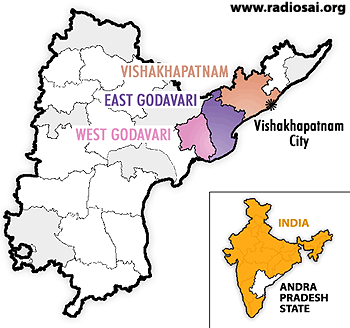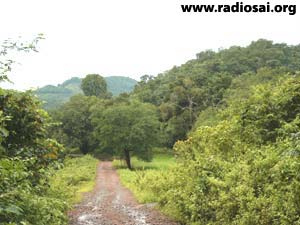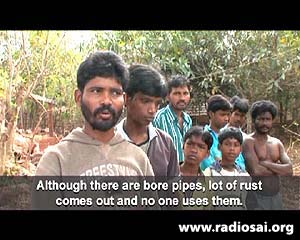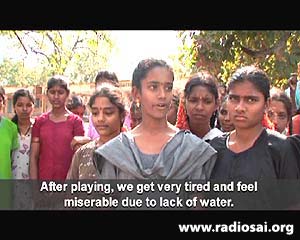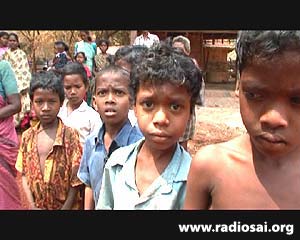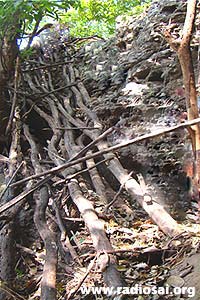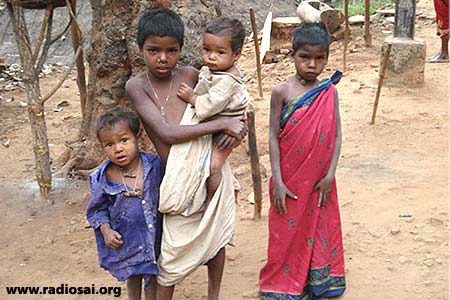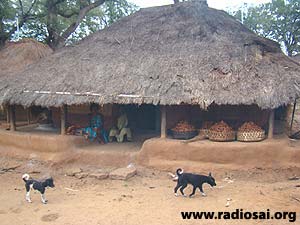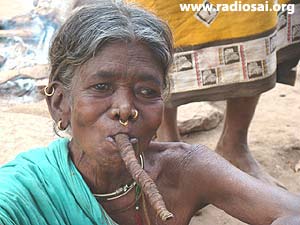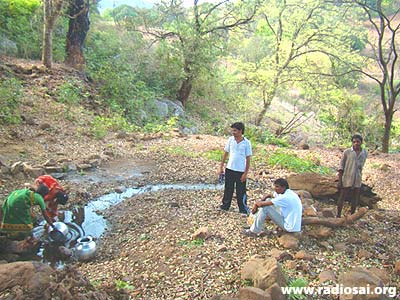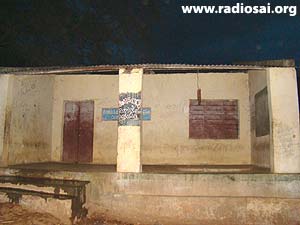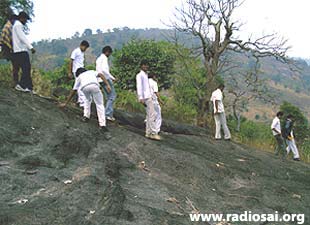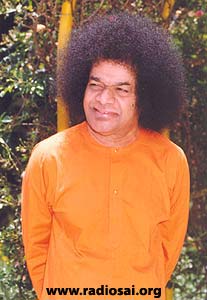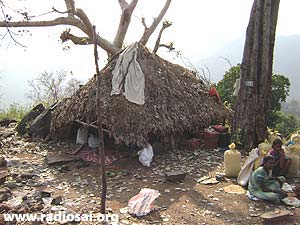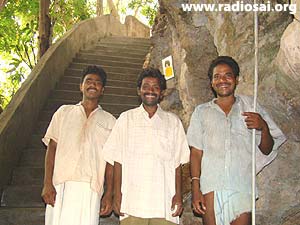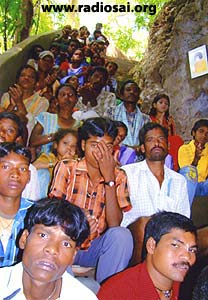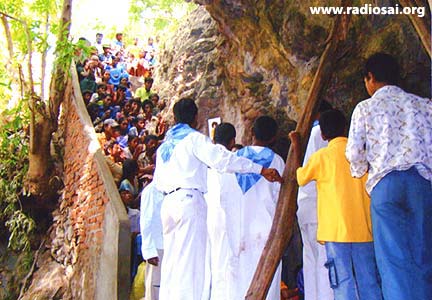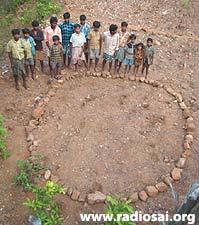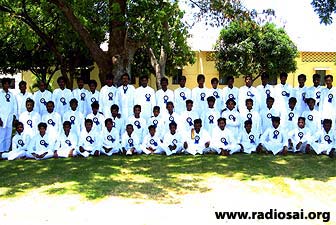 |
 |
 |
Volume
6 - Issue 05
MAY - 2008 |
|
Transforming the Tribals - A Tale of Only Love
When the All India President of Sri Sathya Sai Organisations visited the interior and hidden hilly regions of East and West Godavari districts of Andhra Pradesh in late 2007, he was speechless, overwhelmed with the love of the tribals of the region. They sang and danced in joy on seeing an emissary of Bhagavan Baba in their solemn hamlet. It was their opportunity to express how much they loved their ‘Sai Ram’, but for whose munificence they would be mired with disease, hunger and helplessness. A 14 year old said, “In our school, we had no water. Because there was no water, we had no school on many days. But now all of us study and are happy. Sai Baba has provided us clean drinking water. We love Him.” A young adult said, “Earlier, the water we got by digging wells, used to be filled with lot of dirt and pollutants. But now we have clean drinking water. It is a boon for us. “Another inspired lady, who is a little prosperous among the tribals, gave away her huge land holding to Sathya Sai Organisation to erect a structure which could house her ‘Sai Ram’ whenever He visited their village. For all these tribals, who lived in bamboo huts and survived on roots and tubers of the forest, absolutely untouched by civilization, the very fact that a group of people in whites talked to them with love and concern with no other ulterior motive was itself like a sweet dream. But here there was someone who was giving them clean drinking water at their doorstep, unasked. They are clueless how to convey their gratitude. “We will carry ‘Sairam’ on our shoulders and bring Him to our village,” they say with great enthusiasm and love.
Truly, what Bhagavan Baba has done for the 500 villages of East and West Godavari districts so silently, without even an announcement of the launch or the inauguration of the mega service project that proffered much needed pure water to quench the thirst of half a million natives, is as astounding as it is awe-inspiring. In December 2005 issue of H2H, we had a cover story on this mammoth drinking water project, we plan to offer you another comprehensive cover story on this unique project in a couple of months, but now here is another stirring story inspired by this model and magnificent service initiative of Bhagavan Baba.
When a group of Sai Youth from Vishakapatnam, a coastal town in the eponymous district of Andhra Pradesh, saw the profound impact of Swami’s drinking water project in the life of tribals, whose health, life styles and habits have changed dramatically for the better, they too decided that they would undertake a similar project in their region. If these self-motivated youth had any resource worth the mention, it was only their burning passion to make a difference. Otherwise, they had neither money nor material nor huge man power. Some of them were still in college while others had become employees of public or private companies not many years ago. Searching out Society’s Most Disadvantaged Having decided, they fixed a date to start their noble mission. It was to be December 14, 2007. On this Friday morning, this group of seven set out on their quest to do a survey of the rural areas located away from the Vishakapatnam city, and if possible visit a few tribal areas, and zero in on a few particular villages or hamlets which would be their chosen fields of selfless work in the next few months. Their journey began at 7 am in the morning. At 11 am, they were at Gummukotta, a tribal village at the foot of the Ananthagiri Ghats (which are part of the range of mountains called the Great Eastern Ghats of India). From here, if one wanted to visit the interior tribal villages, it had to be done only on foot. As the youth started talking to the residents of Gummukotta, they met a Vidya Volunteer (teachers deputed to teach in rural areas by the government) who suggested that they visit the tribal hamlet “Sankhuparthi” located in the same Ananthagiri Mandal of Vishakapatnam district. The name “Sankhuparthi” resonated inside every youth because it had in it a part of Bhagavan’s birthplace, Puttaparthi. Moreover, it was in the Ananthagiri mandal, just as Puttaparthi is in Ananthapur district. So, the youth decided that their first stop will be this village which had such a unique nomenclature. For them, it was a direction from the Divine.
Though the name of the hamlet was so inviting, the approach way to it was intimidating. The youth had to trek through rocks and boulders, mud and dirt for seven long kilometers with the midday Sun sapping their depleting energy every second, before they saw any hut or signs of any habitation. Mind you, this trek was not on the plains or on a downward slope, but on a seventy degree upward incline. Hill Temple Provides Spiritual Sustenance It was 1 pm now and one village gentlemen, Naidu, who was accompanying them from Gummukotta, said, “Before you visit Sankhuparthi, you must visit the temple of Mallanna Swamy (another name of Lord Shiva). It is a very powerful and sacred shrine for all the tribals of these hills.” The Youth decided to take his advice. They were in for a surprise when they reached the place. There was no temple as they had imagined; it was just an opening to a cave that was 50 feet deep from the top of the hill, which is where they were standing. And was there a way to reach there? Yes, but a perilous one. There were no steps of stone or concrete to climb down; only a damaged and risky ladder made from braches of trees lay as the only means to reach the sacred spot. Having come till there, the Youth decided to take the challenge. Stepping carefully on the pieces of wood, they were on all fours as they slid and crawled carefully, holding on to the name of the Lord as tightly as to the dried stems of trees. When they finally reached the bottom, they were in awe. “Oh my God! Here is a beautiful Shiva lingam!” they exclaimed. There were other statues too, one of Lord Ganesha and the other of Mother Parvati. “Nobody knows who installed these statues here,” Naidu explained. “They have existed for thousands of years and for all the tribals, Mallanna Swamy is their God.”
The Sai Youth too had no second thoughts on the mystifying power of the shrine, because all of them felt energetic once they were in front of the idols. In fact, they were so full of vigour and overcome with such devotion, that in spite of their exasperating journey till then, they collected water from a tiny spring that flowed inside that cave and performed 108 times Abhisekham to the Shiva lingam chanting the sacred hymns from the Vedas. They followed this with enthusiastic bhajans and concluded it with arathi (quite surprisingly, they found camphor and other puja materials there). To them, the whole episode was another auspicious sign, a blessing, before getting started with their survey of tribal villages. Shocking Scenes of Deprivation
Feeling rejuvenated, they eagerly trudged along to their destination, Sankhuparthi. By the time they reached this tribal settlement, they had done nearly five hours of trekking on the hilly and difficult terrain. But there was more exasperation in store for them, now not so much physical as much as mental. They were shocked to see the living conditions of the people of the hills – in one phrase, it was ‘utterly pathetic’. “The children had hardly any clothes on them, their faces were sunken and dry, while their stomachs were unduly bloated (typical of malnourished children),” recalls Sai Kumar, a Sai Youth. “As houses they had only thatched huts which provided protection from neither sun nor rain, nor insects or wild animals. In fact, it was appalling to see the tribals sleep with cattle and sheep!” he continues, the pain very evident on his face. “The adults, who looked diseased and over-aged, seemed so very docile and disoriented.” The Youth tried speaking to the young men, but none would answer; they were as if in a state of stupor, not in this world. The only answer the youth received from every adult was a blank face. They were stupefied and clueless. Then, Naidu explained, “All these tribals are under the intoxicating effect of ‘Maddikallu’”. Maddikallu apparently was an alcoholic drink which was prepared by allowing the cooked rice to ferment for three days. “But why do all of them consume this? Do they prepare this themselves?”
They were only getting more and more curious. The fact that the tribals consumed such a drink during the day when they should have been engaged in some activity confounded them. “Well, they have nothing to do,” answered Naidu. “And this Maddikallu helps them sleep long hours and forget all their pains.” The faces of all the adults, the Youth saw, were highly wrinkled and weathered down, having been exposed to the forces of Nature living as it is on the top of the mountain.
A woman of forty looked as if she was past eighty, thanks to their poor habitat and highly damaging habits. The Youth were shocked to see one of the aged women puffing in a long country cigar with the lighted end inside her mouth! “Because of this, many of them have throat cancer. Nobody lives beyond 45-50 in this hamlet,” Naidu, again, added. Not Even a Drop of Pure Water For the youth, it was a continuous experience of shock, disbelief and sorrow. Their heart bled when they saw one or two tribals trying to dig small holes in a particular area, where a stream flowed few days ago, searching for water. Desperate to quench their thirst, these men of the hills wanted to salvage every little drop they can from under the ground. “The problem of water is perennial here,” Naidu explained to the Youth. “They do not have water to drink, let alone cooking or taking care of their health and hygiene. It is for this reason that almost all of them have skin diseases. They do not have bath for days and months together.”
“If they do not have water, then how do they cook and make Maddikallu?” one of the Youth asked inquisitively. “Oh..they do not prepare Maddikallu themselves,” Naidu answered. “Every Tuesday there is a big market at the foot of the hills and all these tribals go there with their collections of forest produce which could be tamarind or jack fruit, honey or herbs, or some leaves and berries. They barter all their forest products for Maddikallu. After Tuesday, they indulge in it till their drink lasts and do no work.” School on Permanent Holiday In that hamlet of 25 families, everybody – men, women, children – drank this deadly potion and whiled away their time. But what surprised the Youth was a school building in one corner of the hamlet. “Do classes go on here?” they asked. “No, the government constructed this building a year ago, but no teachers come here. There is one teacher who comes once in six months,” one of the tribals explained. The school even had a toilet – the only one in the village – but there was no water. Similarly, the hamlet luckily even had an electricity connection and a few bulbs, but power was rare. As a result, all the villagers slept once the Sun set. The only meaningful activity they engaged in was growing a few crops like ragi and other cereals, but since this was dependent on rains, this was an occasional and irregular occupation.
The heart wrenching living conditions of the tribals was an eye-opener for the Youth. They longed to do something for the unfortunate ones, but communicating with the tribals was still an ardous task. Apart from the language barrier, which was because the tribals spoke in a different dialect though it had resemblance to Telugu, the tribals were still very suspicious of their intentions. Having been victimized by many political groups in the past who sweet talk and promise many things but never deliver, they were very cautious. The Youth concurred that a decent water facility is a must for the region, but at the same time, before they start any project of that nature, they needed to first break the ice and gain the confidence of the tribals. Another Pitiful Village Greets the Seva Dal
It was almost 3 in the afternoon now and as the youth were discussing their next plan of action, a tribal from the neighbouring hamlet, requested the Youth to visit their village too. The tribal was insistent; he thought, maybe, the Youth might want to offer something to his village too. In any case, the Youth trekked two kilometers and reached the adjacent hamlet, Boorjuvalasa. Here, the conditions were actually worse. The children were naked, there was no water or no power. Here too, sadly, all the villagers resorted to Maddikallu. But one object in this village bolstered their levels of enthusiasm. Quite unexpectedly, they found a picture of Bhagavan Baba, on the dilapidated doors of one of the huts. When questioned, the tribals said they had no clue how the picture came there. Maybe, the picture came along with the door a few years ago, one tribal said. Whatever be the source of the picture, for the Youth, it was again a positive sign from The Divine. Upon enquiry, the Youth found that the source of water to this village was from a stream located in another hamlet situated much above the hills, but the tribals of that village never released any water for Boorjuvalsa. The youth now wanted to visit this ‘highly placed’ hamlet called Galipadu. It was a journey for more challenging than they had done so far. For more than an hour, they climbed through a ninety degree incline which was rocky, dry and rough. By now they had exhausted all the water and other energy supplements they had carried before their start. It was 5 by the time they were in Galipadu.
The only noticeable difference in Galipadu was a stream, but even this was highly contaminated. In small pots, the villagers collected water that was stagnant and polluted, the water pool being a breeding ground for many germs. Sometime ago, there were pipes laid from this stream in Galipadu to the other village below, Boorjavasala. But the tribals of Galipadu did not release water to any third party. The youth now had a clear picture of the water crisis in these regions. It was almost dusk now and before it became too dark, they trekked down and returned to Vishakapatnam. Giving Joy with a Christmas Meal
Their survey had been successful. They had identified people who are in dire need of help, especially water. Though a safe drinking water project was the ultimate objective, they decided that they had to go about it stages. First and foremost, they had to build a healthy relationship with the tribals; they needed to just share love. Therefore, their first activity was a grand Narayana Seva. They knew that on Tuesdays, the tribals from all the hamlets converged at the foot of the hills in Gummukotta for the weekly market. So, on December 25, 2007, a Tuesday, they served a delicious meal to all the men of the mountains. More than 3000 people ate to their hearts content sweet rice, tamarind rice, curd rice and curry. They were overjoyed and grateful. They saw the Sai Youth as a group of people who want to contribute to their health and happiness without expecting anything in return. After this event, which was a big success, the Youth planned a second activity in the month of January in 2008. Since the month of January is extremely cold and on the mountains, it is only more severe, they decided to distribute blankets to the tribals of all the three hamlets; but they had no resources. Every member of the youth team had contributed already for the Narayana Seva, and none of them were highly prosperous either. Like for every selfless activity, help came quite mysteriously. Blankets Given with Love
One day as the Youth were discussing this project in the house of one of the elders of the Sai Organisation, the moment they broached this idea, a flower fell from the portrait of Bhagavan. The senior devotee was so thrilled that he immediately offered to sponsor the entire amount needed to purchase blankets, and even advised that the textile should be of high quality. So it was that as divinely ordained, the blanket distribution project too went off like a breeze. By now, the tribals were convinced that the Sai Youth were their true friends and well-wishers. They knew these young men in whites wanted to help them genuinely. When the Youth now asked them how they could help to make their lives better, the tribals, unanimously, had two requests. First, a solid ladder to go down the cave to worship their God, Malanni Swamy; and second, provision for safe drinking water. Creating a Staircase to Their Heaven Their devotion to Malanni Swamy moved the Youth. Proper approach to the cave was a request that every tribal from every hamlet made emphatically. Therefore, while the thought process for the water project was underway, the Youth started with the Temple project. This was all the more important because it was already the month of February, and in another four weeks was the most holy festival for the tribals – Maha Shivarathri.
As a first step, the Youth informed the elders in the Sai Organisation about this project and requested some of them to visit the place. Accordingly, one day, in the second week of February, a few senior members including the Sevadal and Spiritual Coordinator for the state of Andhra Pradesh, set out to visit the area.
After they began their journey, the Youth members became very concerned, as that day turned out to be rainy. To reach the cave, one needed to trek seven kilometers and it was impossible to undertake the adventure if it poured from above. The youth prayed as they reached the foothill, Gummukotta, and to their joy and disbelief, just when they reached the village, the rain stopped! It was 10 in the morning. All the elders of the Organisation visited the area and approved their idea of constructing a strong ladder to the cave for the tribals. “But, it cannot be done in 2-3 weeks, you will need at least a month,” said the Spiritual Coordinator, who was by profession a civil engineer. The youth were understandably not happy to hear this. They wanted somehow to offer a good ladder to the tribals before the festival arrived. In any case, they listened to the elders, neither concurred nor disagreed to their views, and at the same time, never gave up their hopes. The Sacred Work Inspires Tribal Unity Meanwhile, the Youth took the opinion of other engineers and everybody said that to construct a concrete ladder which is strong and steady, a minimum of four weeks was unavoidable. But the Youth believed that somehow they would be able to build the steps in time for the festival. On February 18, 2008, one youth member’s uncle, who was a senior mason with a good deal of experience, reached the area to begin the work, accompanied by another mason. The Youth had decided that they would begin the work with men and material available, and work hard as well as pray hard.
All of them did the job of a labourer – carrying bricks, cutting stones, mixing concrete, etc. Mind you, transporting bricks, cement and other material from down under up the seven kilometer rocky terrain, plainly, was a Herculean task, even by the standards of the strong labour men. But seeing the youth sweating it out so selflessly for them, the tribals were only too touched. Soon, an army of men from the hills joined in; hundreds of tribals appeared from all the hamlets. It was a task for their Malanni Swamy and they were prepared to do anything for Him. Instantly, the Youth had united all the tribals and at the same time, become recipients of their love and unstinted support.
This unity and enthusiasm of the tribals did wonders! All the jobs happened in record time, be it cutting the stone, laying bricks or placing concrete. With the help of just two masons and one engineer, the 50 feet staircase was ready in 10 straight days! What is most moving is that during all these 10 days, the Sai youth worked day in and day out, and can you believe it? For nearly two weeks, they stayed in an isolated and dilapidated hut, next to the temple, which was generally used by the tribals as a godown for grains! They drank the water that flowed in the stream at the bottom of the cave and used the same to clean themselves. For the tribals, the Shiva Lingam in the cave was Shiva Himself and the small stream that flowed was the holy River Ganga. The youth too felt the same way. They became completely one among them! And how did the tribals respond? Every night, a group of tribals guarded this hut with guns (given to them by the government for self-protection) to protect the Sai Youth from the attack of wild animals. For the tribals, the Sai Youth were their best friends; a phenomenal bond of love now united both the groups.
Before camping in the hut, the Sai Youth carried provisions for their food for the next 10 days, and everyday they cooked and served all the tribals who were working non-stop for the ladder construction. If one was at the scene, it would have been difficult to spot the Sai youth from the others, as the tribals too were now smiling and wearing nice clothes – all gifted by the Sai Youth.
To the great joy of Sai Youth, three full days before Maha Shivarathri, the construction of concrete steps, was complete. On the day of the festival, the thrill of the tribals was unbelievable. They gathered in hundreds and celebrated with jubilation. “Till now, only male members could go inside the cave, but now our wives, daughters and small children also can go down to worship Malanni Swamy. This is such a great boon for us,” said one elderly tribal. The Youth filled the air with sacred Vedic chants and vibrant singing of bhajans. They were, in fact, in tears, out of sheer joy. What seemed impossible had so dramatically materialized as if God was at work at every step. And sure, He was, you will know as you read on. Seeking His Blessings After the grand culmination of the Temple project, the Youth now wanted to concentrate completely on the problem of providing drinking water. They did a special survey of the region along with a Hydro Geologist, and even finalized a site for digging a well at Gudipadu. Once this water became available, the water problems of all the villages would be solved, they were sure. They could supplement this with the water from the natural spring near Gudipadu village, and supply, through pipes, to all the three hamlets. Now, suddenly everything seemed doable as the tribals were highly cooperative and receptive everything the Youth did. But before taking up the project, the Sai Youth wanted to have physical blessings of Bhagavan, and so, they planned a trip to Prasanthi Nilayam. They did not come alone; they brought all the tribals too along with them to Bhagavan. They were in Puttaparthi on April 3, 2008.
Swami Recognizes the Tribals’ Plight
The next day, as they sat in Sai Kulwant Hall awaiting His Darshan, they were overwhelmed with the grandeur and peace that pervaded the Hall. When Bhagavan came on the gents side, He lovingly accepted letters from all the tribals. He even spoke to one of the villagers, Ashok, enquiring about his village and district. Then He asked, “What do you want?” “Drinking water, Swami,” the villager replied. Immediately, the Sai Youth took the opportunity to explain to Swami their plan of action. The Lord listened to everything, saw the specially prepared brochures by the Sai Youth and blessed the project; still, the tribals were not pleased. They wondered why did Swami not take the brochure when He was taking letters from so many devotees. So, they suggested the Sai Youth to write letters to Swami in white papers and offer to Him the next day. The Youth did exactly as the tribals wanted, and sure enough, on the morning of April 5, 2008, when a Sai Youth, Ganesh, offered to Swami the plan for the water project, Swami said, “I know… I know about this project. Go ahead. You have My Blessings.” The tribals were now extremely satisfied. Kannayya, one of the tribals said, “When we saw Sai Baba, we felt we have seen God… we know, now all our problems will be solved… the Sai Youth have treated us like their kith and kin, They are so full of love. We always felt God has sent them for us and now we have seen God.” Again, on April 6, 2008, a Sai Youth, Sai Kumar, prayed to Swami during Darshan, “Swami, we need Your Blessings for these tribals.” The Lord gently smiled and said, "Manchidi..manchidi (Good…good).” Abandoning Bad Habits - Improving Their Community The tribals were overjoyed to see Bhagavan, no doubt. But the most important aspect of the whole endeavour was the transformatory effect it had on them. When asked if they would still continue their custom of child marriages, where girls get married when they are just 12, another tribal Sriramulu said, “We did not know that this is not right. It has been this way in our community for generations. But now, if the Sai Youth ask us to change the practice, we will do so willingly; because they are the only ones who speak to us with so much love and affection.”
Ashok, the villager from the foothill, who was very touched when Swami spoke to him the first day, said, “Until I saw the Sai Youth serving, I always thought helping the tribals is somebody else’s duty. But now I have seen, learnt and realized. I will try in my own way to educate the tribals and keep them away from bad habits. Additionally, I will arrange for every tribal person to have official papers assigning ownership of their land, so that they are more aware of their rights.” Always ecstatic when recalling that special moment, he joyously expressed, “I could not believe Sai Baba was speaking to me! I was thrilled. Now I know I am surely going to lead a happy life because Baba is there to protect us. I have all the strength to accomplish my goals.” That is how much charged up the tribals and villagers were once they had His Darshan. For the Youth, it was another dream come true. April 7, 2008 was Ugadi, the Telugu New Year day, and the Youth had stitched new pairs of white clothes to gift all the tribals on that day. The tribals were moved with their love and gleefully posed for a picture with the Youth in Prasanthi Nilayam as a sweet memory. The tribals and the Youth returned from Puttaparthi charged with inspiration to complete the project. And now, as you read this article, the works are on to construct an open well at Galipadu, and divert water from the natural spring to Sankhuparthi, Boorjuvalasa and other villages. Additionally, the Youth are also planning to camp in the villages by turns and educate the tribal children. They have also prepared a time table for conducting periodic medical camps in Gummakotta Village. There are also other projects in the offing like teaching handicrafts and other trade skills, so that the tribals are kept busy and can earn a decent livelihood.
- Bishu Prusty
Dear reader, how did you like the article? Did it inspire you in any way? Please share your feelings with us at h2h@radiosai.org. |
|||||||||||||||||||||||||||||||||||||||||||||||||||||||||||||||||||||||||||||||||||||||||||||||||||||||||||||||||||||||||||||||||
Vol 6 Issue 05 - MAY 2008
|
Best viewed in Internet Explorer - 1024 x 768 resolution. |

